Welcome to my second batch of articles for April which include:
· Easter flowers - and a recipe
· a look at tulips
· some more jobs to be getting on with
· a quiz
Easter
What’s the first colour that springs to mind when you think about Easter? For me it’s yellow. Fluffy yellow chicks; yellow-gold of the foil around my Easter egg (if I get one, that is) – but above all, flowers, and particular parts of a couple of them – I’ll explain about the parts later.
First, the Lenten Lily, or daffodil. Or strictly speaking Narcissus pseudonarcissus. I’m pretty sure these are the golden daffodils that Wordsworth recalls from his nebulous perambulations beside Ullswater in the Lake District.
There has been much argument over whether Narcissus pseudonarcissus is a British native – and from the research I’ve done, the discussion is ongoing. However, we can be pretty certain that this daffodil is the one we see growing wild. The description given by the Royal Horticultural Society, who calls N. pseudonarcissus ‘wild daffodil’, describes it as ‘a small trumpet daffodil up to 35cm in height, with usually glaucous foliage and flowers 4-6cm in width, with deep yellow trumpet and pale yellow perianth segments’. That’s the one!
Its most common name is Lent or Lenten Lily because it can usually be found flowering during the period of Lent, which begins on Ash Wednesday and ends at Easter. Given that Eater is a moveable feast (Easter Sunday being the first Sunday after the full moon after the spring equinox - so the earliest Easter can be is 22nd March, and the latest, 25th April) and the vagaries of the weather, it could be that our little daffodils are well and truly over by the time Easter arrives. They are little in comparison with their cultivated relatives, some of which can grow up to 50cm in height, but what they lack in stature they make up for in abundance because they will happily colonise an area if they like the conditions. However, please don’t be tempted to dig any from the wild to put in your garden: there are legal ramifications. Besides which you can buy bulbs from reputable nurseries and suppliers.
My second yellow Easter flower, the primrose, Primula vulgaris is also a wild flower. Both the common and Latin names give us a lot of information. The common name is derived from the Latin prima rosa, which means ‘first rose’ of the year; its flower does look like a miniature single rose. But it seems disrespectful to call these little beauties vulgaris until you realise that it means ‘common’ in its original sense of ‘widespread’. This tells us that it was once indeed widespread throughout Britain, but like so many of our native plants loss of habitat has seen a decline in its numbers. So, like the Lenten Lily, please source your plants from a reputable nursery.
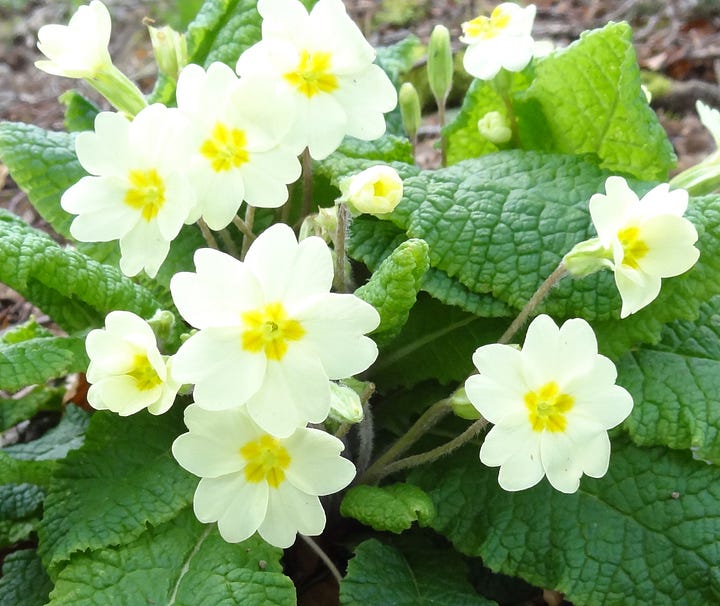
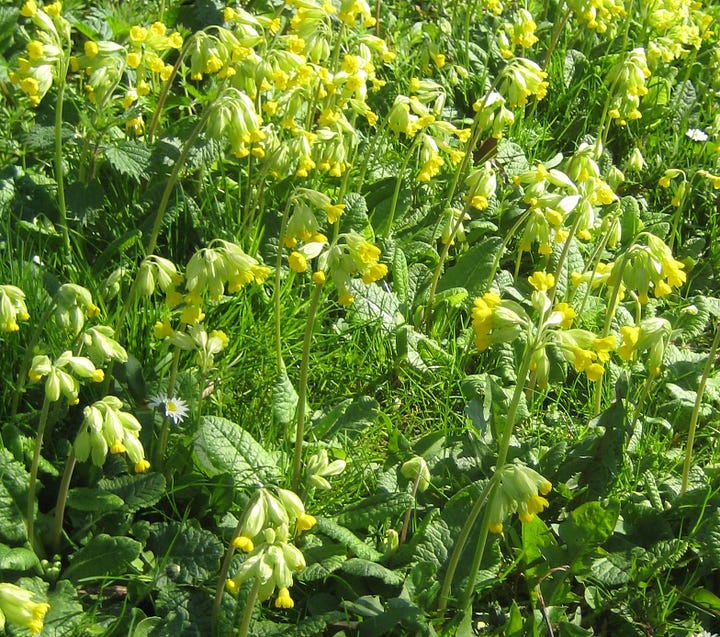
I remember that when I was a child, primroses, along with their cousins the cowslip, Primula veris, my third Easter flower, grew abundantly on the land of our local farmer. He allowed me and my sister to wander quite freely in the copse – where we would find primroses – and in the pasture where the cowslips grew, even allowing us to pick a few to take home for our Mum.
One abiding memory I have is, one sunny afternoon during what must have been a late Easter holiday, lying face up in one of the fields looking at the clouds, surrounded by cowslips. The sweet, honey perfume and butter-yellow colour of those fairy bells will stay with me forever, they are my ‘scent of memory’: Proust has his petites madeleines, I have my cowslips.
I mentioned earlier that parts of flowers also remind me of Easter. I’m being a bit disingenuous with my first ‘part’ because it’s not part of the flower - it’s actually the leaves of a plant with yellow flowers. The plant is tansy, Tanacetum vulgare. Grown as an insect repellent and strewing herb (it’s mentioned as such by Tusser in his Five Hundred Pointes of Good Husbandrie of 1557) and to remedy gout and intestinal worms (!), its bitter leaves were also used in tansy pudding, known simply as Tansies. They were a bit like custard tart, flavoured with the juice of young tansy leaves which were eaten on Easter Day as a remembrance of the bitter herbs eaten at the Passover.


My last ‘flower part’ is saffron. Saffron is the name given to the dried, deep-red stigma of Crocus sativus, an autumn-flowering crocus with rich lilac flowers.
You can grow your own in a sunny, well-drained spot, but be warned it takes about 150 flowers to produce one gramme of saffron – no wonder it’s the most expensive spice in the world. When it’s added to recipes it adds a rich golden hue, so distinctive that the name saffron has become synonymous with the colour itself.
So, where’s the connection with Easter? It’s Simnel cake, a bit like Christmas cake but much lighter. We’re used to seeing a round fruit cake topped with a layer of marzipan, and often with a layer of marzipan in the middle, finally decorated with 11 marzipan balls representing the good apostles. This decorated form probably dates to the ‘Bury Simnel ‘of 1863 which was presented to Queen Victoria. Many people think that the marzipan was coloured with saffron to make it a buttery-yellow colour rather than the pale almond colour of its main ingredient. But the saffron was originally added to the cake itself, which, surprisingly, was boiled before it was baked. Here’s a poem from the intriguingly named 1867 book Copsley Annals: Preserved In Proverbs, by Emily Elizabeth Steele Elliott (my emphasis):
She who would a simnel make, / Flour and saffron first must shake, / Candy, spices, eggs must take, / Chop and pound till arms do ache: / Then must boil, and then must bake ….
I’m not sure I’m up to all that chopping and pounding, so I’ve found a much easier Simnel recipe which includes all the accepted ingredients and is as equally yummy as the traditional version.
Easy Easter Simnel Cake
Ingredients
175 g butter
150 g soft light brown muscovado sugar
3 large eggs
175 g plain flour
1 tsp. baking powder
1 tsp. mixed spice
Pinch saffron, finely ground with a pestle and mortar
75 g currants
75 g raisins
75 g sultanas
50 g mixed peel
Finely grated zest of 1 lemon
150 g marzipan, cubed
Method
1. Preheat oven to 180°C (160°C fan) Gas mark 4. Grease and line a 20cm x 20cm tin.
2. In a large mixing bowl beat together the butter and sugar, until very pale and fluffy.
3. Add the eggs, one at a time, beating thoroughly after each addition.
4. Sieve the flour, baking powder, spice and saffron together and gently fold in to the mixture.
5. Fold in the remaining ingredients, except the marzipan.
6. Spoon half of the cake mixture into the prepared tin. Sprinkle half of the marzipan over the top, followed by the remaining cake mixture. Spread evenly then dot over the last pieces of marzipan on top.
7. Bake in oven for 40-45min until a skewer inserted into the middle comes out clean. Leave to cool in the tin for 5min then turn out onto a wire rack to cool completely. Cut into 16 pieces to serve.
So, there we have it - my yellow flowers (and parts of flowers) which remind me of Easter – and a recipe thrown in!
Tulips
We’re into tulip season and for many years I had a bit of love-hate relationship with tulips. I’m not entirely sure where the hate bit came from. It probably has to do with the fact that, if you leave them in the ground, many varieties will only give you one sensational display and then pretty much give up the ghost. They might deign to throw up one single leaf the following year but that’s it. All that effort for one diva-like display. I think, too, it might also have to do with the fact that you often see them planted in regimented rows, all standing to attention – something which really grates with me.
I have learned to love tulips, though. These days I’m a bit more easy-going. I’m quite happy to plant some tulip bulbs knowing that I’m unlikely to get a second season out of them. I no longer plant them in the ground, however. Now I plant my bulbs in containers which involves a lot less back-breaking work – something which I value more the older I get. I make sure the containers are in-situ and then add the compost and plant them up.
I have a series of deep terracotta pots that I use for my tulips. The keyword here is deep. As a general rule of thumb, you should plant bulbs three times as deep as their height. Given that the average tulip bulb is about 4-5cm in height, you should plant them so that the base of the bulb is about 12-15cm below soil level. The pots I use are about 30cm deep so there is enough soil for the roots to get into.
Talking of soil, the most important thing to remember is that it should be free-draining – too much moisture and the bulbs will rot.
As for spacing, you can place the bulbs quite close together as long as they aren’t touching. If you are planting them in the ground, space them about 8cm apart. And once you have planted them, water them in: this will help to settle the soil around the bulbs.
Whether you plant your tulips in the ground or in containers, don’t be too eager. Although other spring-flowering bulbs can be planted in September, wait until late October or November, or until the soil temperature drops below 15°C, for your tulips. The colder temperature will help prevent viral and fungal diseases taking hold.
As for varieties, there are thousands to choose from: there are short species tulips – some only growing as tall as 10cm which are beloved by pollinating insects; and then we those growing up to 80cm. There are single-flowered, and double-flowered tulips; there are those that are as near black as nature will allow, to pure white, and almost every colour of the rainbow in between; there are ones that flower in early spring and those that don’t bloom until late spring.
One combination that I tried out was wine-themed, with tulip varieties ‘Burgundy Lace’, ‘Merlot’, and ‘Pomerol’ (below in order) – it was a winner.
Whatever varieties you choose enjoy the unrivalled display of these beautiful bulbs.
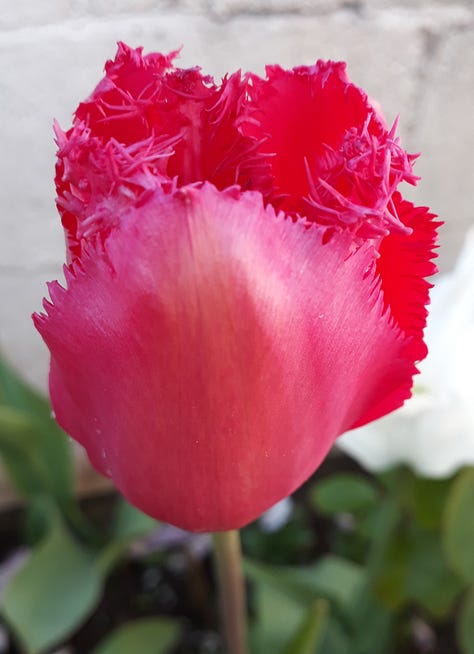
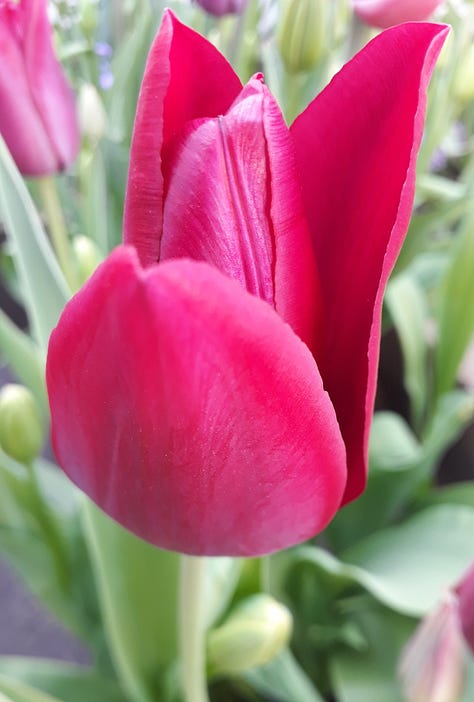
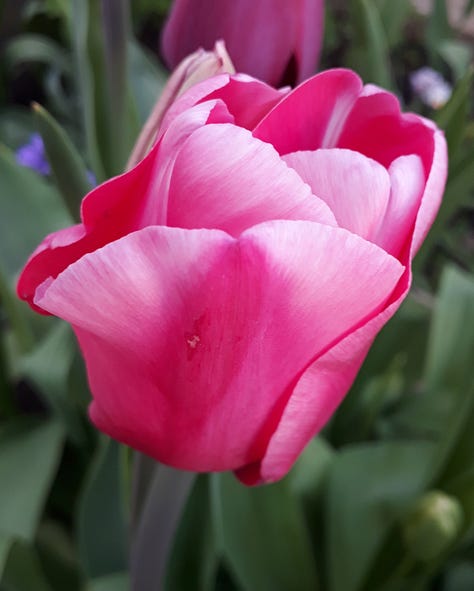
Here are some more …
Jobs for April
Plant gladioli corms in a sunny, well-drained spot. They look lovely in the border and make ideal cut flowers.
Now is a good time to repot shrubs in containers, including citrus plants. Choose a pot one-size up and repot using a peat-free compost with a little grit added. If the shrubs don’t need repotting, take away the top 5cm of compost and replace it with fresh.
Some perennials, such as delphiniums and phlox are ideal specimens from which to take basal cuttings. As long shoots (7-10cm) emerge cut them close to the base (hence basal) and plant them in individual pots. Pop them in a heated propagator, or cover them with a clear plastic bag. They will root in no time.
Any hibernating wildlife will have vacated compost heaps by now, so now is a good time to turn the compost.
Sow some herbs, such as basil, chives, coriander, fennel and parsley, under cover to be planted out later in the season.
Deadhead any remaining daffodils. Remove the old flowers but leave the foliage so that the plant’s energy is directed towards the formation of next year’s flower bud within the bulb. Let the foliage die back completely or cut back six weeks after deadheading.
Quiz
Following on from the classical music piece On Hearing the First Cuckoo in Spring featured in one of my articles earlier this month, here’s a quiz with a classical music bird theme.
All the compositions have a bird (or more than one) in the title.
Can you fill in the missing word? (Answers at the end.)
Note: all titles have been translated into English.
1. S _ _ _ Lake (Tchaikovsky)
2. The C_ _ _ _ _ and the N _ _ _ _ _ _ _ _ _ _ (Handel)
3. The G _ _ _ _ _ _ _ _ (Vivaldi)
4. The L _ _ _ Ascending (Vaughan Williams)
5. O _ _ _ : An Epitaph (Elgar)
6. The B _ _ _ _ _ _ _ _ (Messiaen)
7. The R _ _ _ _’ s Wedding (Grieg)
For more information about The Bee Garden and what I get up to, please have a look at my website www.thebeegarden.co.uk which also features my online shop.
And as a thankyou for signing up to receive these articles you can get a 10% discount on all items in the shop: simply enter SUB10 at the checkout and the discount is automatically activated.
Quiz Answers
1. Swan Lake
2. The Cuckoo and the Nightingale
3. The Goldfinch
4. The Lark Ascending
5. Owls : An Epitaph
6. The Blackbird
7. The Raven’s Wedding
Picture credits:
Narcissus: free download from www.biodiversitylibrary.org/page/299562. Tansy, Saffron: Pixabay. All others: my own






A very interesting and diverse newsletter, thank you!